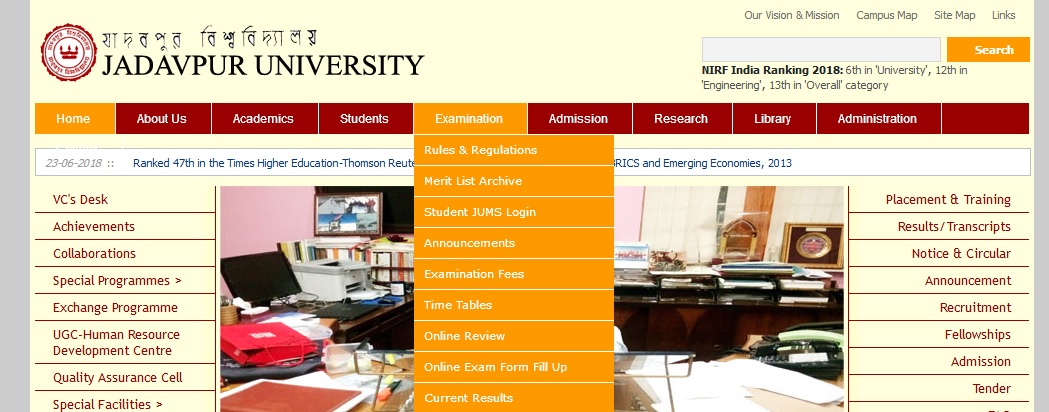Non-Impact Printing B.E Question Paper : jaduniv.edu.in
Name of the University : Jadavpur University
Department : Printing Engineering
Degree : B.E
Subject Code/Name : Non-Impact Printing
Year.Sem : IV/I
Website : jaduniv.edu.in
Document Type : Model Question Paper
Download Model/Sample Question Paper : https://www.pdfquestion.in/uploads/dspace.jdvu.ac.in/5376-Non-Impact%20Printing.pdf
Jadavpur Non-Impact Printing Question Paper
B. E. Printing Engineering 4th Year Examination, 2013 :
[1st Semester, Supplementary)
Non-Impact Printing :
Related : Jadavpur University Printing Machine Design B.E Question Paper : www.pdfquestion.in/5445.html
Time: Three hours
Full marks: 100
Model Questions
Answer any 4 questions :
1.
a) Describe in detail the basic steps of xerographic process with required diagrams. 20
c) Name different commonly used photoreceptors in xerography with their spectral responding characteristics. 5

2.
a) Write notes on the following development processes 15
i. Cascade development
ii, Magnetic brush development
iii. Impression cylinder development
b) Briefly describe the working principle of binary deflection DOD printing 7
c) How does triboelectricity phenomenon play important role in xerography? 3
3.
a) Describe the thermal transfer printing process with required diagrams, 8
b) Describe the importance of development electrode,
c) Describe few ink related problems commonly occur in inkjet printing.
d) Briefly describe the composition of inkjet ink, 5
4.
a) Describe the working principle of multiple deflection continuous jet inkjet printing with required diagram,
b) What is supply efficiency? Derive the relationship between the discharge rate
5. a) Describe the principle of piezoelectric type DOD inkjet and the different designs that are commonly used in this type of DOD inkjet printers. 12
b) Describe thick and thin film print head? 8
c) State the advantages and disadvantages of indirect thermal printer in comparison with direct thermal printer. 5
5.
a) Describe different components of an inkjet printhead with required diagram. 8
b) How satellite drops are formed? What are the advantages and disadvantages associated with this phenomenon?
c) Describe different phases of PIDC,
Syllabus
Electrophotography : Introduction to electrophotography, alternative powder marking technologies, electrophotographic processes & subsystems.
Related physics, development steps, two component development system, cascade development, magnetic brush development both insulative & conductive systems, monocomponent & liquid development, xerographic sensitometry, TESl, electro-graphic colour processes. photoelectric materials, Applications of electro-photography.
Inkjet Printing : Introduction to inkjet printing. Types of inkjet technologies. Continuous and drop on demand inkjets printers, Printhead design considerations, Inkjet inks: non-aqueous, aqueous, hot-melt inks,
Substrates : plain paper, coatings Thermal Printing: Introduction to thermal printing technologies. Direct thermal and Dye-diffusion thermal transfer. Chemistry of thermal papers.
References:
** Lane, Earle, Electrophotography, And/or Pr.
** Scharfe, Merlin E., Electrophotography Principles and Optimization, John Wiley & Sons.
** Schein, L.B., Electrophotography, Laplacian Press; rev. 2nd edition.
** Shaffert, R.M., Electrophotography, Focal Press, London
* Springer Verlag, Electrophotography and Development Physics,
** Sturge, J. & Walworth, V. & Shepp, A., Imaging Processes and Materials (Neblette’s eighth edition), Van Nostrand Reinhold, NY, USA
Color Vision And Colorimetry :
The Eye, Colorimetry, Visual Equivalence and Visual Matching, Uniform Color Scales, Visual Thresholds, Theories and Models of Color Vision.
Psychophysics : Hierarchy of Scales, Threshold Techniques, Matching Techniques, One-Dimensional Scaling, Multidimensional Scaling, Importance in Color Appearance Modeling, Munsell color, The Swedish Natural Color System (NCS), The Colorcurve System, Other Color Order Systems,
Uses of Color Order Systems Color-Appearance Phenomena: Simultaneous Contrast and Spreading, Color Constancy Viewing Conditions: Configuration of the Viewing Field, Stimulus, Proximal Field Colorimetric Specification of the Viewing Field,
Modes of Viewing, Illuminant and Illumination Chromatic Adaptation, Computational Color Constancy Color Appearance Models: CIELAB, Wrong von Absorption of Light (Phenomenological Theory) : Phenomenological Theory and ItsSignificance,
Four-Flux Theory, Kubelka-Munk Theory, Hiding Power, Transparency, Principle of Spectral Evaluation Light Scattering and Absorption Depending on the Content of Coloring Material (Beer’s Law, Scattering Interaction) Scattering and Pigment Content,
Systematic Treatment of Pigment/ Achromatic Paste Mixing, Kubelka-Munk Functions of Pigment/Paste Mixture, Tinting Strength (Corpuscular Theory), Mie Theory Determination of Hiding Power, Tinting Strength and Lightening Power